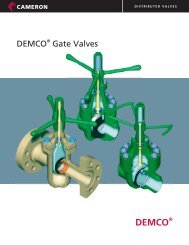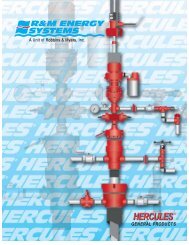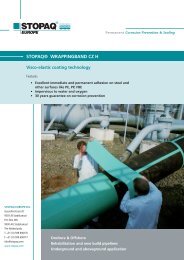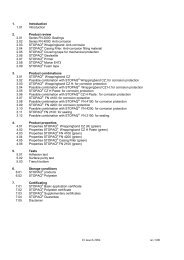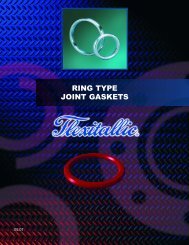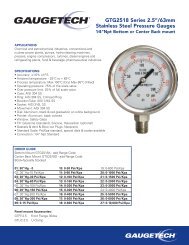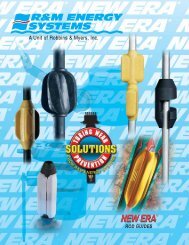Welcome to the Next Generation of Sealing ... - CE Franklin Ltd.
Welcome to the Next Generation of Sealing ... - CE Franklin Ltd.
Welcome to the Next Generation of Sealing ... - CE Franklin Ltd.
Create successful ePaper yourself
Turn your PDF publications into a flip-book with our unique Google optimized e-Paper software.
ASME Boiler and Pressure Vessel Code Calculations<br />
Gasket Seating Stress "y"<br />
Defined as <strong>the</strong> applied stress required <strong>to</strong> seat <strong>the</strong> gasket upon <strong>the</strong> flange faces. The actual required seating stress is a function<br />
<strong>of</strong> flange surface finish, gasket material, density, thickness, fluid <strong>to</strong> be sealed and allowable leak rate.<br />
Gasket Fac<strong>to</strong>r "m"<br />
Appendix II, Section VIII, <strong>of</strong> <strong>the</strong> Boiler Code makes <strong>the</strong> statement <strong>the</strong> "m" fac<strong>to</strong>r is a function <strong>of</strong> <strong>the</strong> gasket material and construction.<br />
We do not agree entirely with this interpretation <strong>of</strong> "m". Actually, <strong>the</strong> gasket does not create any forces and can<br />
only react <strong>to</strong> external forces. We believe a more realistic interpretation <strong>of</strong> "m" would be “<strong>the</strong> residual compressive force exerted<br />
against <strong>the</strong> gasket contact area must be greater than <strong>the</strong> internal pressure when <strong>the</strong> compressive force has been relieved by<br />
<strong>the</strong> hydrostatic end force”. It is <strong>the</strong> ratio <strong>of</strong> residual gasket contact pressure <strong>to</strong> internal pressure and must be greater than unity<br />
o<strong>the</strong>rwise leakage would occur. It follows <strong>the</strong>n, <strong>the</strong> use <strong>of</strong> a higher value for "m" would result in a closure design with a greater<br />
fac<strong>to</strong>r <strong>of</strong> safety. Experience has indicated a value <strong>of</strong> 3 for “m” is satisfac<strong>to</strong>ry for flanged designs utilizing Spiral Wound gaskets<br />
regardless <strong>of</strong> <strong>the</strong> materials <strong>of</strong> construction. In order <strong>to</strong> maintain a satisfac<strong>to</strong>ry ratio <strong>of</strong> gasket contact pressure <strong>to</strong> internal<br />
pressure, two points must be considered. First, <strong>the</strong> flanges must be sufficiently rigid <strong>to</strong> prevent unloading <strong>the</strong> gasket due <strong>to</strong><br />
flange rotation when internal pressure is introduced. Secondly, <strong>the</strong> bolts must be adequately prestressed. The Boiler Code recognizes<br />
<strong>the</strong> importance <strong>of</strong> pre-stressing bolts sufficiently <strong>to</strong> withstand hydrostatic test pressure. Appendix S, in <strong>the</strong> Code, discusses<br />
this problem in detail.<br />
Notations<br />
A b<br />
Am<br />
Am1<br />
Am2<br />
b<br />
b o<br />
2b<br />
G<br />
m<br />
N<br />
P<br />
Sa<br />
Sb<br />
W<br />
Wm1<br />
Wm2<br />
y<br />
Sg<br />
do<br />
di<br />
= Actual <strong>to</strong>tal cross sectional root area <strong>of</strong> bolts or section <strong>of</strong> least diameter under stress; square inches<br />
= Total required cross sectional area <strong>of</strong> bolts, taken as greater <strong>of</strong> Am1 or Am2; square inches<br />
= Total required cross sectional area <strong>of</strong> bolts required for operating conditions; square inches<br />
= Total required cross sectional area <strong>of</strong> bolts required for gasket seating; square inches<br />
= Effective sealing width; inches<br />
= Basic gasket seating width; inches<br />
= Joint-contact-surface pressure width; inches<br />
= Diameter <strong>of</strong> location <strong>of</strong> gasket load reaction; inches<br />
= Gasket fac<strong>to</strong>r<br />
= Radial flange width <strong>of</strong> spiral wound component<br />
= Design pressure; psi<br />
= Allowable bolt stress at atmospheric temperature; psi<br />
= Allowable bolt stress at design temperature; psi<br />
= Flange design bolt load; pounds<br />
= Minimum required bolt load for operating conditions; pounds force<br />
= Minimum required bolt load for gasket seating; pounds force<br />
= Minimum gasket seating stress; psi<br />
= Actual unit stress at gasket bearing surface; psi<br />
= Outside diameter <strong>of</strong> gasket; inches<br />
= Inside diameter <strong>of</strong> gasket; inches<br />
The ASME boiler and pressure vessel code is currently under review by <strong>the</strong> Pressure Vessel Research Council. Details <strong>of</strong><br />
<strong>the</strong>se proposed improvements, including <strong>the</strong> effects on gasket design procedures are highlighted on page 43.<br />
40<br />
<strong>Welcome</strong> <strong>to</strong> <strong>the</strong> <strong>Next</strong> <strong>Generation</strong> <strong>of</strong> <strong>Sealing</strong> Technology<br />
®



